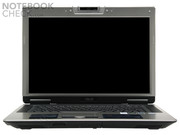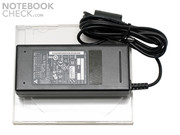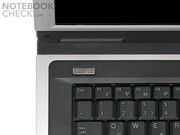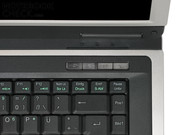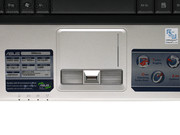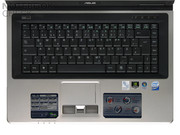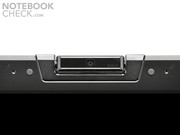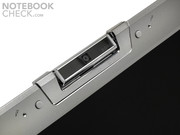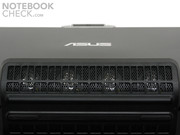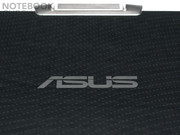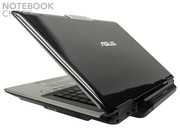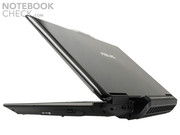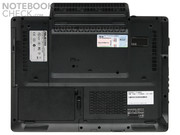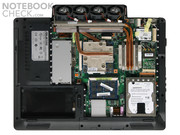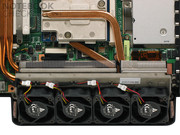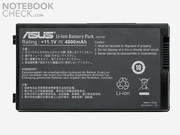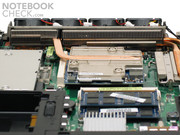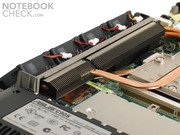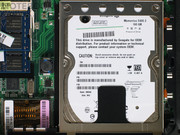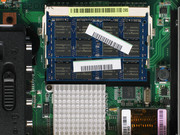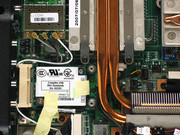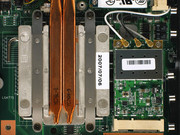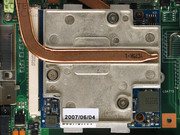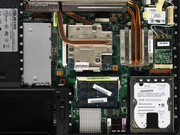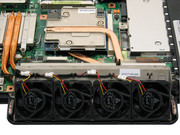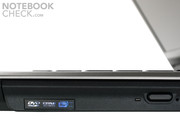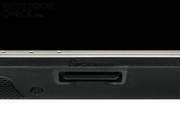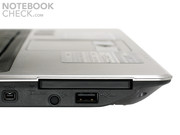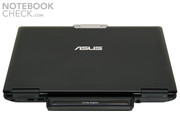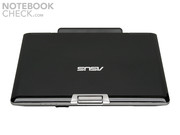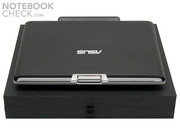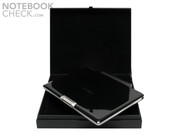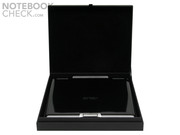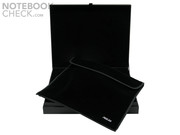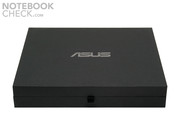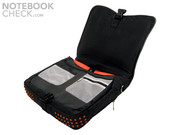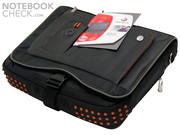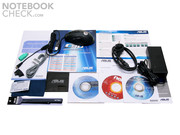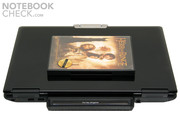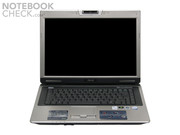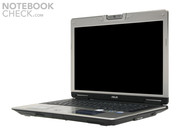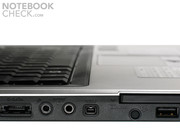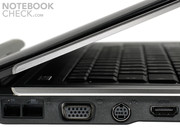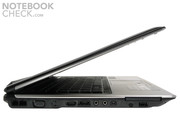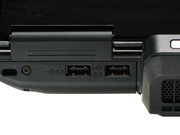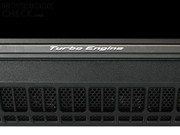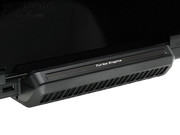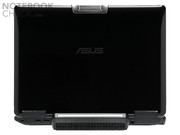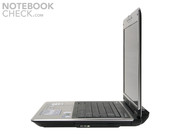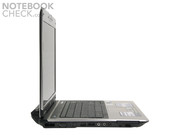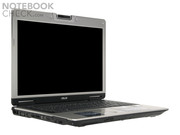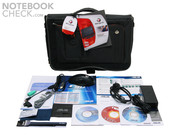Test Asus C90S (AK001C) Power-Notebook
Lid with glossy finish and useful accessories
The high performance Asus C90S (AK001C) was once intended as a barebone notebook, which could be upgraded by the user. Now the C90 series is sold under the name Asus C90S (AK001C) as a preassembled model, with a powerful desktop processor (!) and the possibility to overclock. Obviously we were excited to see, how well this 15.4" beast would do in our performance test.
Robust case and clean manufactoring
Stability and twist stiffness of the Asus C90S (AK001C) at the upper and lower frame are completely acceptable, despite the relative high weight of over three kilograms. The same holds true for the case body of the Asus notebook, which doesen't appear to be too soft in relation to its weight. In view of the targeted price tag it comes as no surprise that the case consists mainly of plastic materials, though this doesen't have a negative influence on the good quality. However, not even the extensively equipped Asus C90S (AK001C) is spared the typical plastic creaking noises. Fortunately, they stay in acceptable regions at all times and don't become annoying. Furthermore, compared with other producers in this price and performance category, we couldn't really find something to complain about the surface feeling of the notebook.
Extensive interface
In terms of interface and additional equipment the Asus C90S (AK001C) manage to leave even some expensive 17" desktop replacement notebooks in the dust.
The C90S scores on the left side (from the back) with modem- and a LAN-port, as well as a VGA, S-Video and a HDMI connection. Especially the high resolution multimedia interface HDMI (high definition multimedia interface) is a future proof connection, which is implemented in virtually all modern LCD televisions as well as Blue Ray- and HDTV-players. HDMI can be used, for example, to transfer high resolution image signals (HDTV) from notebook to a suitable HDTV appliance.
Communication equipment, webcam, fingerprint scanner and TPM-module
Like the interface, the communication equipment of the Asus C90S (AK001C) offers everything one needs to get connected, be it wireless or over cable.
The Asus C90S establishes a wireless connection to the home network or the internet with the integrated WLAN card, which supports the new and up to 300MBit/s fast 802.11n-Draft-standard (802.11a/b/g/n). According to press reports by Asus Germany the Asus C90S (AK001C) will be delivered with an Intel next generation wireless-N WLAN card. But our test sample contains an Atheros wireless LAN module AR5008X with AR5416/AR5133 chip set.
Brute processor performance thanks to desktop CPU and overclocking
The specs of the Asus C90S (AK001C) sound insane - at least for a 15.4 inch notebook. Not a notebook processor does the calculations in the C90S but a desktop dual core CPU: Intels Core 2 Duo E6600 with a clock rate of 2,4GHz per core. The E6600 has a 1,066MHz fast front side bus (FSB) and can use four megabyte second level cache for both cores (shared L2 cache).
However, considering the available and well performing notebook processors like the Intel Core 2 Duo mobile T7600 with 2,33GHz clock rate, the T7700 (2,4 GHz) and the Core 2 Duo T7800 with 2,6GHz, 4MByte L2 cache and 800MHz FSB, the question what a power hungry desktop CPU is doing in a notebook inevitable arises.
Asus writes on its global web site that the Asus C90S (AK001C) can be equipped with processors up to the Intel Core 2 Extreme X6800 (4MByte L2 cache, 2,93GHz, 1,066MHz FSB), which means a power consumption of up to 75 watt (!) by the CPU alone. Unfortunately we failed to find out whether the small case or the 90 watt power supply unit melts first, since we didn't have a X6800 CPU. However, the Asus C90S with an E6600 and some overclocking gets pretty hot already, and reaches its limit regarding heat and stability. But more about this topic later in this review.
As briefly mentioned in the last preceding paragraph, we had problems with our test sample to get to higher clock rates than approximately 2,763MHz with the Asus tool "Turbo Gear" in the mode "overclocking". After questioning Asus we were - unfortunately after sending back the Asus C90S (AK001C) - told to either install the new Bios version C90S0801.rom or to use a 120 or 135 watt power supply unit instead of the 90 watt power supply unit. But we already looked into this before and got several surprising results.
All following benchmarks were taken without overclocking the Asus C90S.
| 3DMark 2001SE Standard | 23334 points | |
| 3DMark 03 Standard | 9729 points | |
| 3DMark 05 Standard | 6021 points | |
| 3DMark 06 Standard Score | 3209 points | |
Help | ||
| PCMark 05 Standard | 5173 points | |
Help | ||
Medium class graphic card Nvidia Geforce 8600M GT holds the replacement rocket back
Processor wise the Asus C90S (AK001C) is well prepared for all demanding tasks, whether they are in 2D or 3D, thanks to the strong desktop CPU E6600 and the significant over clocking potential. However, with nowadays powerful dual core processors by AMD and Intel as well as fast RAM and mass storage working in notebooks, the graphic card usually turn out to be the weak link in games.
Fast, large hard disc and standard DVD burner
The 160GByte hard disc made by Seagate, which is integrated in our Asus C90S (AK001C), is a current drive of the 5400.3-Momentus series. The ST9160821AS has a modern serial-ATA interface and uses an 8MByte cache to buffer data. According to Seagate, the ST9160821AS rotates 5400 times per minute. The ST9160821AS inside the Asus C90S performs very well in direct comparison with its competitors. The ST9160821AS achieves 4,7 points on the performance index of Windows Vista, while other 5400 r/min hard discs are mostly between 4,0 and 4,4. We test the average transfer rate of the ST9160821AS with the help of HDTune, and compare it with the 2,5 inch reference disc, the Seagate Momentus 7200.1 (ST910021AS) with 7200 r/min and are positively surprised. The fast core components of the C90S and the rapid Seagate disc work perfectly together and manage impressive 35,5MByte per second. This result places the Momentus 5400.3 very close to the approximately 38MByte/s of the 7200.1.
Short battery lifetime and very high noise level and temperature
The Asus C90S (AK001C) is a real desktop replacement when it comes to power consumption and noise, both are very high. In addition, it makes the room heating redundant. Because of this, the Asus notebook is best used stationary connected to the power grid, despite the portable 15,4" format, since the battery life time is simply too short.
One can only feel sorry for the 53,28 watt hour lithium-ion batteries in light of the incredible power hungry C90S which needs 65,3 watt (!) in idle mode. The Asus C90S (AK001C) sucks the 4.800mAh battery completely dry after an hour and 13 minutes, and this in the really undemanding battery eaters Readers test. In the classic test the lights of the Asus C90S turned off after one hour on battery, and under full load it took just over half an hour. Those who can do without performance and display brightness can extend the battery life slightly with the "Power Saving" mode. However, this cannot hide the fact that a desktop replacement notebook, like the Asus C90S, isn't made to run on batteries.
Surface temperatures
(±) The maximum temperature on the upper side is 42.3 °C / 108 F, compared to the average of 36.9 °C / 98 F, ranging from 21.1 to 71 °C for the class Multimedia.
(-) The bottom heats up to a maximum of 54.7 °C / 130 F, compared to the average of 39.2 °C / 103 F
(+) The palmrests and touchpad are cooler than skin temperature with a maximum of 30 °C / 86 F and are therefore cool to the touch.
(±) The average temperature of the palmrest area of similar devices was 28.7 °C / 83.7 F (-1.3 °C / -2.3 F).
Glossy, high resolution display
The Asus C90S (AK001C) uses a strongly reflecting 15,4 inch notebook widescreen LCD (Colour Shine, Glare Type) made by CMO (Chi Mei N154Z1-L02). Exceptional: With a 1,680 x 1,050 pixels (WSXGA+) it offers a very fine resolution. Due to the reflecting surface of the Asus C90S display it is not very ergonomic: Light that falls on the screen is almost unfiltered thrown back. This is not quite as bad as it seems though, thanks to the high average brightness of almost 180cd/m2.
The horizontal viewing angle dependency of the display is usual compared with other displays of this TN-type (Twisted Nematic). Vertically on the other hand, only a relatively small viewing angle is possible. Overall we rate the viewing angle dependency of the Asus C90S (AK001C) as satisfactory. Mainly because of the reflecting surface coating (Colour Shine, Glare Type), the colours appear subjectively brilliant and full compared with a dim display, without leaving a "this is too much" impression.
| |||||||||||||||||||||||||
Brightness Distribution: 78 %
Contrast: ∞:1 (Black: 0 cd/m²)
Verdict
The Asus C90S (AK001C) is an extreme desktop replacement notebook, and certainly not for everybody. At first, the C90S doesen't stand out due the 15,4 inch screen, but a big surprise in the shape of a desktop processor is hiding under the hood. The extreme processor performance for little money is the main selling point for potential buyers of the Asus C90S. Other qualities, like the possibility to over clock and the modular construction for later system upgrades, were completely ignored by Asus Germany.
Furthermore, the Asus C90S contains an almost flawless interface for a 15,4" notebook. Apart from HDMI, the C90S notebook has an eSATA connection for fast connections to external memory medias. The C90S also offers various possibilities to communicate: From Gigabit-LAN over WLAN to Bluetooth, it has everything a mobile notebook companion needs nowadays.
The Asus C90S (AK001C) also sets an example for other producers regarding goodies included in the shipment. A gift box with notebook carry case, the excellent MX518 mouse as well as documentation, recovery and program discs and a fast hard disc recovery option earn our unrestricted praise!
A major downside of the C90S notebook is the, despite the favorable format, very limited mobility due to short battery life, very high noise level and high temperatures. The medium class graphic card fails to impress as well, especially compared to the performance of the other components. On the other hand, the Asus C90S offers with its high resolution widescreen display great multimedia and video capabilities.
This review is an abbreviated short version of the very long original German review. Perhaps now and then the context might be missing. Sorry for the inconvenience. Here you find the complete review in German language.







